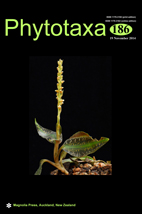Abstract
Rhopalostroma lekae was collected on bark of wood in Chiang Rai Province, Northern Thailand and isolates from the sexual state produced a nodulosporium-like asexual state in culture. A combined multigene sequence analysis was used to infer the phylogenetic position of R. lekae and its affinities with other xylariaceous genera. Rhopalostroma is confirmed to have particularly close affinities with the genera Phylacia and Thamnomyces. Secondary metabolite profiling of R. lekae showed the species to produce binaphthalene tetrol (BNT) as a major metabolite and several minor undetermined metabolites. The phylogenetic placement of R. lekae was resolved using a polythetic approach. Herbarium material and living cultures representing an authentic specimen of R. lekae are deposited in publically accessible collections that can be used in future studies.

